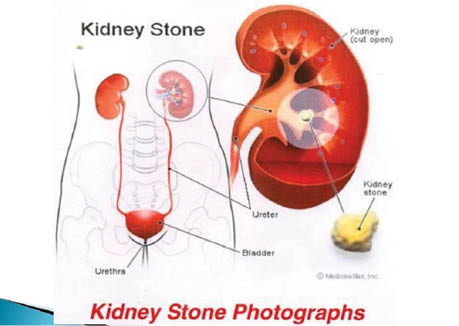I have Kidney Stones
I am so worried and devastated after being diagnosed of kidney stones. I have also been having urination problem for many months and taking drugs. Kindly share simple information with me about kidney stones. Sopia X. Thanks Sopia for your question and I wish you quick recovery and healthy life. Kidney stones can be defined […]

I am so worried and devastated after being diagnosed of kidney stones. I have also been having urination problem for many months and taking drugs. Kindly share simple information with me about kidney stones.
Sopia X.
Thanks Sopia for your question and I wish you quick recovery and healthy life. Kidney stones can be defined as a solid piece of material that forms in the kidney out of substances in the urine. A stone may stay in the kidney or break loose and travel down the urinary tract.
A small stone may pass all the way out of the body without causing too much pain. A larger stone may get stuck in the ureter, the bladder, or the urethra. A stone can block the flow of urine and cause great pain.
What are the symptoms?
- 1. Extreme pain in your back or side that will not go away.
- 2. Blood in your urine.
- 3. Fever and chills.
- 4.
- 5. Urine that smells bad or looks cloudy.
- 6. Burning feeling when you urinate
Four major types of kidney stones
- 1. Calcium kidney stones is by far the most common type experienced by patients. Around 8 percent of kidney stones can be categorized as calcium-type stones, and of those, most are calcium oxalate stones. These stones are relatively quite small and can usually be passed without the need for surgery. There are a few main causes of calcium oxalate stones. Some instances are the result of a systemic disease, such as bowel disease. However, most are caused by heredity, diet and living habits. Calcium phosphate stones are similar to calcium oxalate stones, but instead of the calcium combining with oxalic acid, it combines with phosphoric acid.
- 2. Uric acid stones are formed when the urine is too acidic. Small crystals can pass through as a gravel-like substance, but since uric acid crystals can form and grow rapidly, there is the possibility that they can become very large and cause serious problems. Risk factors for this type of kidney stone include obesity, diabetes, gout and people with kidney disease.
- 3. Struvite stones are made up of magnesium, ammonium, and phosphate, which are created in the body by certain types of bacteria, the presence of which affects the chemical balance in the urine. These types of stones, also known as infection stones, are more common in women than in men, mostly due to the fact that women are more prone to urinary tract infections.
- 4. Cystine kidney stones are the least common of these types, and they are relegated to those who are born with a kidney disorder called Cystinuria. Its sufferers have kidneys that function well for the most part, but they let abnormal amounts of several amino acids into the urine. Most of these amino acids are harmless, but one is not known as cystine, it can create crystals and stones. These types of stones can begin in childhood and aren’t easy to prevent.
Some treatment options to consider
- 1. Shock Waves (use of a machine that sends shock waves directly to the kidney stone which breaks a large stone and passes in the urine).
- 2. Tunnel Surgery (a small cut into the patient’s back and makes a narrow tunnel through the skin to the stone inside the kidney. With a special instrument that goes through the tunnel, stone is found and remove. The name for this method is percutaneous nephrolithotomy)
- 3. Ureteroscope (a Ureteroscope looks like a long wire). It is inserted into the patient’s urethra then to the bladder and directs it to the ureter where the stone is located. The ureteroscope has a camera that views the stone. A cage is used to catch the stone and pull it out or destroy it with a device inserted through the ureteroscope.
Example of preventive options:
- 1. Drinking a lot of water when eating and between the meals. It helps to flush away substances that form stones.
- 2. Take fruit juices and limiting intake of coffee, tea, and cola.
- 3. Cut down on some foods such as meat.
- 4. Exercise regularly but not a strenuous one.
